Around 700 years before the birth of Christ, two brothers in Boeotia, in what is now mainland Greece, had a disagreement over money. Both worked their own small farms, but while one was an industrious and prosperous farmer, the other, Perses, was a lazy and careless wastrel who eventually had to fall back on his brother for a loan. Perses got more than he bargained for. Rather than simply hand over money or grain, or lend him a plow, his brother decided to give him something far more valuable. He wrote for Perses an epic poem that contained in about 820 lines all the advice a farmer could need in order to prosper; the specific age of the oxen to buy for pulling a plow, the precise dates on which various crops should be planted and harvested, and the way to store surplus crops to fend off future hunger. Perses also learned how to avoid offending the gods upon whom much of his prosperity would depend. Urinating facing the sun, for example, was bound to upset Helios, the sun god. Armed with his brother's wisdom, Perses could not fail to do well for himself, although it would not be easy—the key to survival, the poem warned, was hard work.
Perses's brother Hesiod, the author of this hymn to prudent husbandry, was a farmer-poet who, it was said, learned the art of poetry from the Muses while he tended his sheep. It was also reported that after Hesiod was killed—as punishment for fathering an illegitimate child—his body was tossed into the sea but was borne back to shore by dolphins.
This Greek terra-cotta tableau depicting a farmer trudging behind his ox-drawn plow dates from the seventh century BC, some 400 years after iron was first used in the Mediterranean lands to make plowshares. The eighth-century-BC poet Hesiod recommended that the plow beam and the stock—the part held by the farmer—be made of oak, and that the plow be yoked to two nine-year-old oxen. Where the soil was heavy, a team of as many as eight animals was required. Hesiod also suggested that the plow be guided by a forty-year-old laborer "who will keep his mind on work, not look around for friends, the way a young man would."
Much of Hesiod's poem, entitled Works and Days, portrays a landscape not unlike that of present-day Greece, where farming is a constant struggle against poor soil, barren slopes, and scorching, rainless summers. Never far from Hesiod's mind was the threat of hunger, even of starvation. And if the life of an individual was precarious, so too was the survival of whole early populations. For all the material wealth and cultural achievements of successive civilizations inhabiting the Mediterranean region, famine remained a constant specter. Valleys were filled with the golden wheat of scattered farms, and the foothills were covered with the silver green of olive trees and the darker green of grapevines, but that was not enough. Beyond the cultivated slopes rose white limestone mountains, some as much as 10,000 feet high, gouged with deep ravines and gorges. In places, these slopes were forested with pine and oak trees, but more often they were covered with maqui—a dense scrub of juniper— shrubby oak, and wild olive. A drab brown in the summer and a blaze of color in the spring, this terrain was virtually useless for agriculture throughout the year, good at best for rough grazing. Elsewhere, many streams ran dry in the summer, while in the winter, driving rain washed fertile soil from the hills and swollen rivers carried precious minerals out to sea.
The achievements of the peoples who inhabited the Mediterranean region derived above all from their delicate relationship with this obstinate and often inhospitable
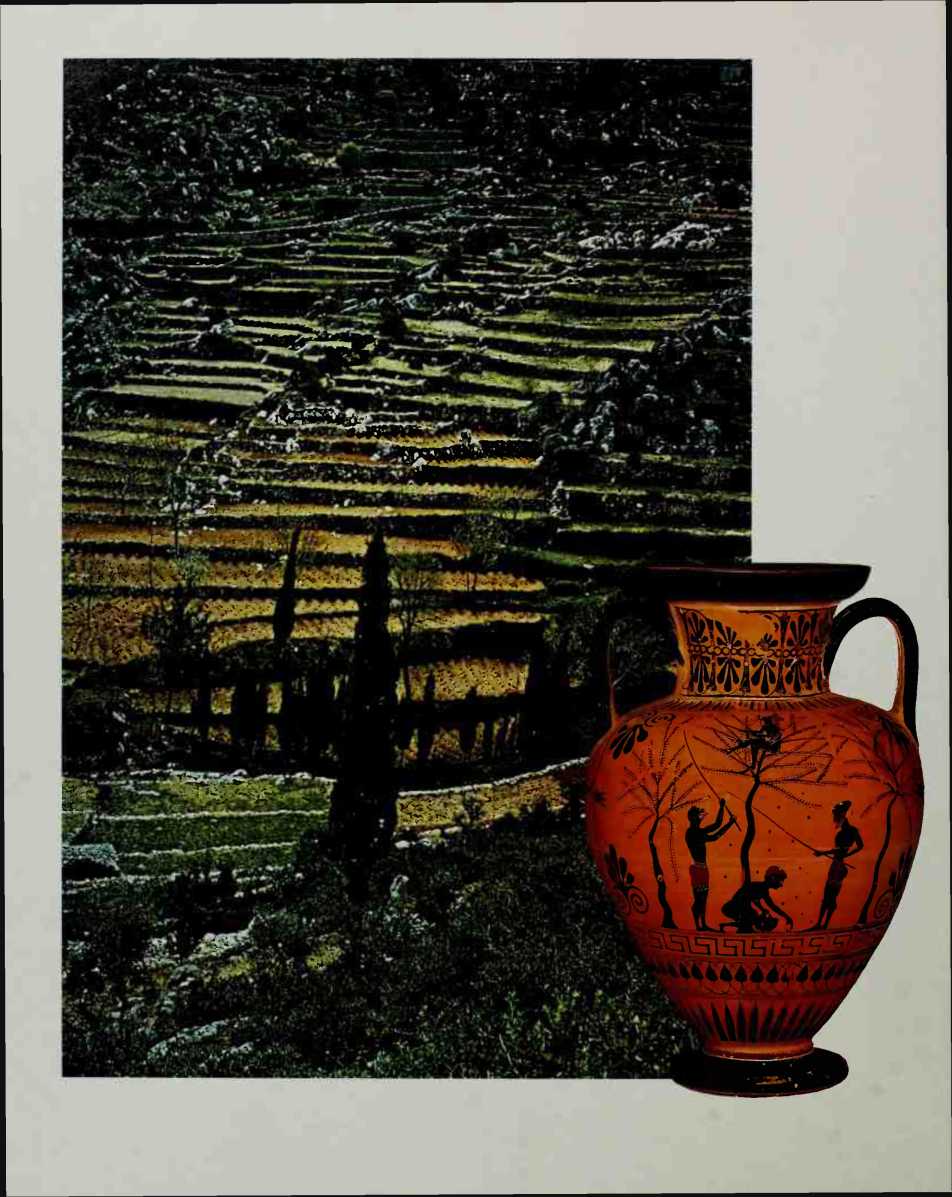
Landscape. The natural world in which they lived shaped their development: It was the abundant fertility of the plains of Mesopotamia that allowed the Sumerians to build the world's first cities; without the mountains that restricted the size of Greek city-states to manageable proportions and without the sunlight that bathed their open-air meeting places, the Greeks might not have been able to develop the prototype structures of political democracy.
This shaping was not just a one-way process, for in their struggle to overcome the limitations of climate and landscape, the peoples of the Mediterranean exerted strong influences of their own. At first, when the population was small, farmers and pasto-ralists were able to satisfy their needs by living in cooperation with the seasonal rhythms of the land. But as their numbers grew and food supply became a pressing problem, they resorted to increasingly ingenious ways of working the soil and making the most profitable use of their limited resources. In doing so, they altered the face of their homeland and discovered that not only rivers and crops but also civilizations may be subject to rhythms of growth and decline.
Steps cut into a hillside on the Greek island of Corfu permit the steep, rugged terrain to be put to maximum productive use. Throughout the Mediterranean region, such hills were once covered by forests; after the trees had been felled for fuel or construction, terraces such as these reduced soil erosion and retained moisture and, beginning around 3000 BC, were planted with olive trees. The Creek amphora (insetj dating from approximately 520 BC is decorated with a harvesting scene: The olives are knocked down with long poles, then gathered into a basket. The jar itself was probably used for storing olive oil, which was used in cooking, for lighting, and in the absence of soap, for cleaning the body.
About 10,000 years ago, when nomadic peoples began to assemble in settled communities in the Fertile Crescent around Mesopotamia for the common purposes of planting crops and breeding animals, the environment itself provided the solution to most of their practical needs. Every spring, the snows of the Zagros Mountains and the Armenian highland melted, swelling the Tigris and Euphrates rivers to coffee-colored torrents that washed over the flatlands. The floodwaters carried with them a mineral-rich alluvial sediment that was made up of fine soil particles mixed with clay and gravel. This material, known as silt, was the Mesopotamian farmer's primary source of fertilizer for the soil on which the richness of his crops depended. The floodwater also served to irrigate the land. In addition, the rivers provided a simple means of communication and transport, so that surplus produce could be exchanged with other communities.
Faced with the natural rhythms of flood, seedtime, and harvesttime, the Sumerians of Mesopotamia assumed they participated in a divine order, and that their society should be a reflection of the orderly ways of the gods. Their religion centered on the worship of an earth mother, and because they believed that the embodiment of male fertility was the bull, they marked the seasonal decline and renewal of the soil by ritual bull sacrifices. There were other early agricultural societies that followed similar fertility rites, some involving human sacrifice, usually of a king who had ruled for a year before being offered up to the goddess—the spilling of his blood represented the fertilization of the soil.
The farmers prospered, and by 3300 BC, they had established the world's first urban center at Sumer, on the plain between the Tigris and Euphrates rivers. Shortly afterward, the city of Memphis was built in Egypt on the banks of the Nile River. As would become the pattern throughout the Mediterranean, these cities were founded on agricultural prosperity: Only in those areas where the land provided enough food to sustain people not directly involved in its production were trade, specialized crafts, and an urban way of life able to develop. But while the new cities themselves accrued great wealth, especially for the emergent ruling classes who controlled the labor of the majority, they changed the whole relationship between their inhabitants and the land from which they had come. The fertile countryside was now under the political control of the cities and subject to new and exacting demands.
A Sumerian poem known as the Epic of Cilgamesh recounts a legend that encapsulates this change. The hero Cilgamesh, ruler of the city of Uruk, determines to challenge the god who protects the forests: "I will conquer him in his cedar wood and show the strength of the sons of Uruk; all the world shall know of it. I am committed to this enterprise: to climb the mountain, to cut down the cedar, and leave behind me an enduring name." The Sumerian cities did indeed require enormous amounts
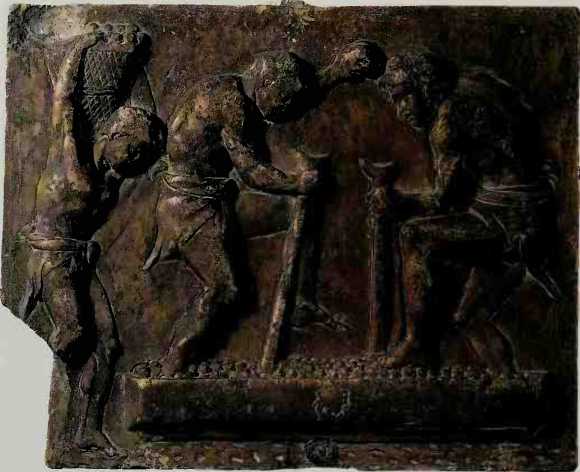
In a Roman slone relief, two laborers pound rods to assist Iheir stamping feet in crushing grapes to make the wine that the Romans, like the Greeks, often drank (diluted) in preference lo waler. The resultanl mash was squeezed by a mechanical press, and the juice was poured into resin-coated vats to ferment. The fourth-century-BC plale on the opposite page is decorated wilh images of a red mullel, a bass, a torpedo fish, a sargus (now extinct), and a cuttlefish. In the time of Homer in the ninth century BC, fish was regarded as a food of the poor; in laler centuries, when wild game was depleted and arable land was used for crops rather than stock raising, fish was for all classes a valued supplement lo their grain and vegetable diet.
Of timber for house construction, pottery firing, and metal-ore smelting. Cilgamesh's successful completion of his task invoked the wrath of the sky god Enlil, however, who threatened a terrible revenge: "From henceforth may the fire be on your faces, may it eat the bread you eat, may it drink where you drink." The practical consequences of the clearing of the woodlands around the headwaters of the Tigris and Euphrates rivers were no less severe: Soil that had previously been anchored to the hillsides by the roots of the trees was now washed down by the rivers, gradually clogging irrigation canals and turning the lowland plains into a barren, salty waste. Deprived of its abundant agriculture, the Sumerian civilization soon weakened and lost its dominance.
Meanwhile, the people of Egypt's new cities continued to flourish along the narrow belt of fertile land on both sides of the Nile, not the least because they had found a source of timber that did not deplete their own limited supplies. Paintings in tombs at Thebes record the visits to Egypt of traders from the three-peaked, wooded island of Crete, which had become one of the Mediterranean's most powerful states by 2000 BC. In the Near East, where cedar was in short supply, its use was reserved primarily for the building of palaces and temples; on Crete, however, it was so abundant as to be used for everyday objects. In addition, the island was richly endowed with oak and pine.
Trade brought great wealth to the Minoan people of Crete, and their rulers built themselves huge palaces at Phaistos, Mallia, Zakro, and preeminently, at Knossos. In time, each palace became the hub of a local hierarchy—made up of bureaucrats, artisans, traders, priests and priestesses, and agricultural workers—that provided a degree of centralized authority over local agriculture and trade. At the same time, the religious practices of earlier cultures were echoed in Minoan rituals that centered on the bull: The god-king, known as Minos, was believed to be the human incarnation of the bull spirit, and on ceremonial occasions, he wore a bull mask during the performance of fertility rites.
As the palace economies thrived, wood was overtaken in importance by other commodities. Hilly and sun-drenched, Crete was blessed with sufficient rainfall to nourish diverse forms of farming. Among these was sheep raising: The palace at Knossos alone controlled flocks that totaled more than 100,000 sheep. Although the island lacked the plains necessary for large-scale crop farming, fields and orchards yielded beans, lentils, peas, lettuce, and fruit such as figs and plums. The sea provided octopus, squid, and fish. Resin from the cypress pine was used for incense and as a varnish for preserving leather and metal. And as well as having storage facilities for surplus grain—which guaranteed food distribution in times of poor harvest—the palaces were stocked with giant ceramic jars containing wine and olive oil, Crete's most important exports.
Wild grapevines grew in abundance on the hilly island, and the Minoans soon discovered the pleasing qualities of fermented grape juice. Wine would become as common a beverage in Crete and Greece as beer had become in Mesopotamia, where a large proportion of the grain production had been consigned to fermentation.
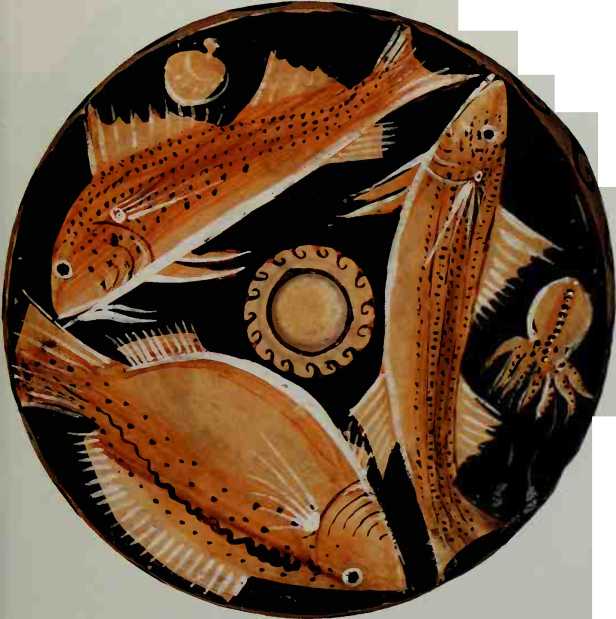
Olives, too, grew wild on Crete, and in time they became even more important than grapes throughout the Mediterranean region—the Greek dramatist Sophocles would later describe the olive as the "sweet gray foster nurse" of his race. The olive tree is notoriously slow growing, taking at least ten years to reach maturity, and its cultivation required both forethought and the willingness to invest resources and labor in a product with only long-term gain. But the olive was also renowned at the time for its hardiness—it could survive droughts that killed off cereal crops— and for the ability of its thin, shallow roots to draw sustenance from barren soil in which little else would grow. As early as the end of the third millennium BC, the Minoans were cultivating the silvery-leaved trees in extensive olive groves. The oil extracted from the fruit proved to be one of the most versatile and valuable products of the Mediterranean world—a fuel for lamps, a basis for perfume or cosmetics, and, most important, a nutritious food that was more dependable than cereal crops.
But while the olive, once matured, renewed itself yearly, useful construction timber was altogether less inexhaustible. In order to provide building wood and fuel for potters and metalworkers, the palace at Knossos—which increased by twenty-eight times its original size within 1,000 years—required extensive forests to be cut down. Builders gradually began to use less timber in house construction, and potters sought al-
Ternative fuels. Clearly, there was not enough forest left on Crete to supply the Minoans' own needs, let alone those of their trading partners. Even the Minoan merchant fleet, lacking supplies of timber for repairing its vessels and building new ones, began to deteriorate.
By 1450 BC, the Mycenaeans of the Greek mainland had not only profited from the Minoans' decline but had also taken over the island of Crete itself, and they proceeded to establish a rich trading empire of their own around the Mediterranean. Timber again was the mainstay of their economy, especially in demand as a fuel for the Mycenaean bronze and pottery industries: The town of Messenia was home to at least 100 bronzesmiths, and pottery was produced on a scale for mass consumption and an international market that spread as far as Italy, Cyprus, and Palestine. But as agriculture boomed and the population rose, and as cities expanded in size and new settlements were created, land and timber became more scarce. By 1300 BC, woodcutters were being forced to venture into the heart of the Greek peninsula in search of suitable trees to fell.
When the cutters had finished their work, nothing protected the earth from the heat of the summer sun or the damage wrought by the driving rains of winter. Soil was washed away by streams that flooded, the slopes around them having lost their capacity to hold water. The plains flooded, too, and crops were smothered by the silt
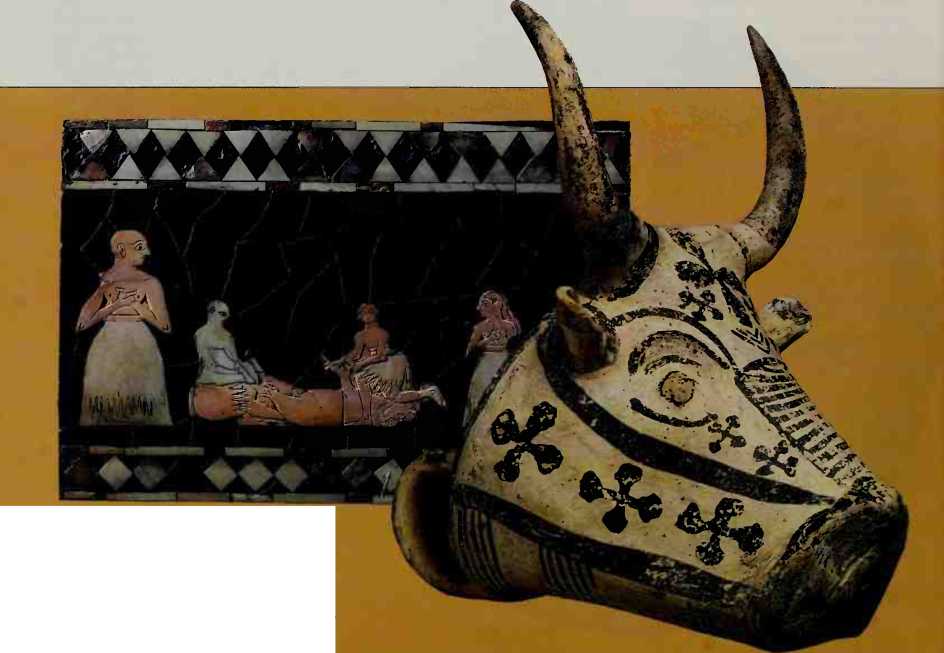
In a relief inlaid with shell dating from 2400 BC (above), a ram is sacrificed in Mesopotamia, where sheep entrails were read by diviners who claimed to foretell the future. The thirteenth-century-BC Mycenaean pottery vessel on the right, cast in the shape
Of a bull's head, was used for offering libations; In the same way that animals were offered up to the gods, liquids such as wine or oil were poured through the bull's mouth onto the ground to propitiate the spirits of the earth or the underworld.
That was deposited by the torrents. Despite the construction of dikes and ditches to divert the water, many regions were by that time beyond reclamation—rich, brown forest soil had been eroded down to the level of red subsoil or white limestone bedrock. To add to the devastation, a period of drought was responsible for the failure of successive harvests. The result was an agricultural crisis compounded by a decline in the essential Mycenaean trades of metallurgy and pottery, which were dependent on now-scarce wood. Whole towns whose economies had been based on these industries were probably abandoned. The population figures plunged. In Arcadia, a mountainous inland area that still retained its forests, refugees from famine were able to survive only by eating acorns.
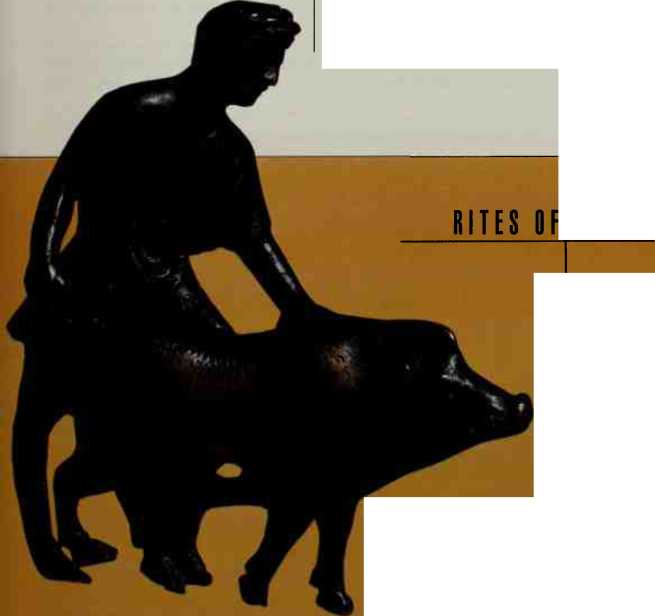
SACRIFICE
Marked for sacrifice by a ribbon, a boar in prime condition is led to its death in a Roman bronze relief from the first century AD. In Roman religious belief, the pig was sacred lo the goddess Demeler.
With the conclusion of the Mycenaean domination of Greece, the land itself fell into a period of decline. Sheep and goats that were pastured on marginal land in the foothills made their own depredations, destroying young shoots that bound the earth together and wearing away terracing that had been built previously for the cultivation of olive trees. In Greek Asia Minor, the effects were still apparent at a much later date; The Greek geographer Strabo noted in the first century BC that so much land was being washed away by one particular river that farmers had decided to sue it. “Lawsuits are brought against the Maeander River for altering the boundaries," Strabo reported, adding that when the river was convicted, “the fines are paid from
The ritual killing of animals was considered by many early societies to be the most effective means of communication with their gods. By offering a gift of something they valued, humans hoped to obtain divine favors—a fruitful harvest, success in war, or a cure for infertility. Through the art of haruspicy, in which a priest discerned omens of future events by studying an animal's entrails, sacrifice also offered a means of interpreting the divine will. Such practices were common to many cultures, as the examples shown here and overleaf illustrate, and the role of sacrifice as a bond between worshipers and their deities persisted in many later-established religions, including Christianity.
The tolls collected at the ferries." The bare-bones appearance that is now characteristic of some parts of Greece became so familiar that later generations assumed it was the natural and immemorial face of the land.
Other regions of the Mediterranean were not so diminished. The Phoenicians, from the area that came to be known as Lebanon, established an extensive maritime empire that was based on timber and textiles, the latter often dyed with secretions obtained by boiling vats of small sea mollusks. (The name Phoenician probably derives from a Greek word meaning "purple dye," referring to the expensive color that in many regions was reserved for the use of the highest members of society.) Around 700 BC, the Etruscans, from the western coast of Italy along the Tyrrhenian Sea, also joined the trading routes, capitalizing on their extensive reserves of metal ore: Their hills held deposits of copper, lead, tin, and—most important—iron, which had become the most sought-after metal for the manufacture of plow blades, tools, and weapons. And the people of Greece, too, gradually learned to survive and even prosper on their altered landscape, bowing their heads to the soil and often looking back with longing to a golden age when, in the words of Hesiod, "ungrudgingly, the fertile land gave up her fruit unasked."
Hesiod attributed the decline of the Grecian soil to the gods' dissatisfaction with humankind. But the gods of Hesiod were different from the gods worshiped by earlier agricultural societies. While the Sumerians, for example, believed that they worked
T t
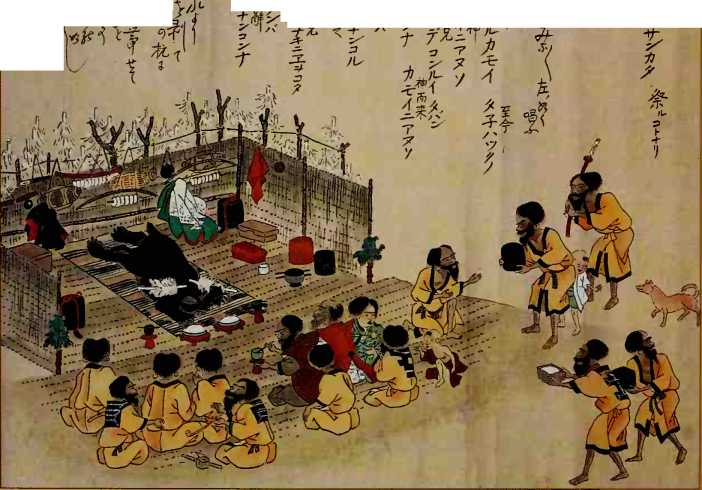
A nineteenth<entury scroll painting shows Ainu families feasting before (he staked-out body of a sacrificed bear. The Ainu—-an aboriginal hunting-and-fishing people still surviving in small numbers in northern Japan—revered the bear as a sacred animal and communed with their god by eating the bear's flesh and drinking its blood. The bear's soul, they believed, would intercede with the spirit world on their behalf. Captured bear cubs were raised in cages for about two years and then killed during an elaborate ritual. At the ensuing feast, the pelt of the bear with the head attached was included in the celebration by being offered a stew made from its own flesh.
The land in order to please their fertility deities, Hesiod clearly labored only for himself, sometimes even in the face of obstacles that the gods had put in his way. Though still immortal and possessed of supernatural powers, the gods were now distinguished by human qualities: They were fickle, envious, and easily hurt. The same qualities were shared by the gods of Homer, the Greek poet of Asia Minor who composed the Iliad and the Odyssey around the eighth century BC. These gods foreshadowed a new trend in Greek thought toward a rational, more human-centered explanation of the natural world.
In one significant aspect, however, the gods of the wellborn Homer and those of the farmer Hesiod were different creatures. The former concerned themselves with prowess on the battlefield—usually the preserve of the rich, who could afford the horses necessary for heroic warfare—and were of little use to poor farmers. Hesiod's gods, on the other hand, appreciated hard work on the land, not the idleness of the wealthy elite whose well-being depended on the labor of others. This contrast reflected a developing division within Greek society between those who worked the land and those who did not.
According to Hesiod, the lords who acted as magistrates were crooked: They ground down their fellow citizens and did not fear the gods. The cause of Hesiod's own bitterness was partly personal—the judges had favored his brother Perses when the two had contended the distribution of the land that had been left to them by their father. But the complaints of the grouchy farmer probably reflected a more widespread resentment. Many of the Greek aristocrats were landowners of huge holdings, which consisted of widely scattered estates that were worked either by tenant farmers, who were obliged to surrender one-sixth of their harvest to the absentee landlords, or by landless peasants. In the Iliad, when Homer had his warrior-hero Achilles imagine the most wretched life he could, Achilles thought of just such an existence, as a poverty-stricken laborer.
Antagonism between the rich and the poor, mirrored in the division between city dwellers and those who lived in the countryside, attended all attempts by the Greeks over the ensuing several hundred years to make their land yield sufficient food for their growing population. By 600 BC, there had emerged a number of powerful city-states, each divided from its neighbors by high mountain ranges, and their populations soon grew too large to be fed and clothed from the meager resources of the hinterland. The problem was especially acute in Attica, a mountainous territory of more than 950 square miles jutting into the Aegean Sea northeast of the Gulf of Corinth: This region, one of the driest in Greece, whose variable rainfall during the growing season frequently caused the crops to fail, was required to support Athens, the largest city of all.
One solution to the problem was to reduce consumption by exporting the consumers. Most early cities on the heavily indented peninsula of Greece lay near the coast, within sight of the sparkling waters of the Aegean; and as food shortages became chronic, the municipal leaders looked not inland but abroad for an answer to their dilemma. Thousands of citizens were dispatched in a great wave of colonization that saw cities established as far away as Spain to the west. North Africa to the south, and Turkey and the Black Sea region to the east.
The colonists who were allotted plots of land around the new settlements were the lucky ones, for within Greece itself, the situation was worsening. One adventurer, sailing from Corinth to Syracuse in southwestern Italy, was reported to have been so hungry that he sold his promised holding for a honey cake. Because most of the productive agricultural land was concentrated in the hands of a wealthy few, and those few were increasingly planting valuable cash crops such as grapes and olives rather than grain for food, poorer farmers were forced to make use of more marginal land with worse yields. There was little opportunity for them to improve their situation. They took out loans to keep their farms going, and if their crops failed, they found themselves in debt. Often the result was that the farmers were forced to serve their creditors as virtual slaves.
Conditions in Athens became desperate, and in 594 BC, the poet and lawmaker Solon was appointed as a mediator between the rich and the poor. To ease the situation, Solon abolished all agricultural debts, allowed better-off farmers to become involved in the process of government, and banned the export of all produce from Attica except olive oil. Other states developed different answers to the problem: In Sparta, for instance, the most valuable land was held by the state and farmed by a special slave class, called Helots; in the Arcadian plain, all free citizens toiled with their own hands. But squabbles between rich and poor continued, and in some cities, the discontent was used by ambitious individuals as an excuse to overthrow the existing government and establish tyrannies, which sometimes resulted in improved conditions for the poor.
The challenge of overcoming the limitations of scarce resources was one factor that led intellectual Creeks to investigate the laws of the natural world. In the fifth century BC, the physician Hippocrates sought rational rather than divine explanations for the diseases he encountered; the historian Herodotus, whose interest in the customs and characteristics of foreign cultures was stimulated by his travels to many Mediterranean countries, came to believe that people's physical, mental, and moral qualities were largely determined by climate and environment. Such theories diminished the influence of the immortal gods and suggested that human problems could be solved only by human solutions.
By the middle of the fifth century BC, the population of Attica numbered more than
200,000 people. Their diet was by no means extravagant: Bread, which was often dipped in wine, was the staple, supplemented by goat cheese and fish and by vegetables such as beans and cabbage; most people tasted meat only on feast days. But because less than half of their land was cultivable, the citizens of Attica had become dependent on imports from grain-rich regions around the Black Sea and from Egypt, and the supply of food had become a crucial political issue. Regulations stipulated that all voyages made by merchant ships financed by Athens had to result in the importation of food, and that no person living in Athenian territory could transport grain to any port other than Piraeus, which served Athens. The penalty for the breach of these laws was death.
A fifth-century-BC bronze relief portrays the squatting figure of Pan, a fertility god of the fields and forests. He is playing on a set of pipes that he fashioned from a bed of reeds into which a fleeing nymph had transformed herself. Roused from his midday slumber, Pan was lustful and unpredictable, liable to induce panic in both flocks and humans. His half-human, half-animal form personified the ambivalent feelings of the Greeks toward the natural world: Like themselves, nature could be both tranquil and unruly, and the line between what was civilized and what was bestial was never defined.
For the Creek city-states, the problems of food supply could be solved only by human intervention and the direct political management of natural resources.
This brought new dangers, as the Athenians soon discovered: Dependence on supplies from abroad rendered the people vulnerable to attack, and when their fleet was destroyed by the Spartans in
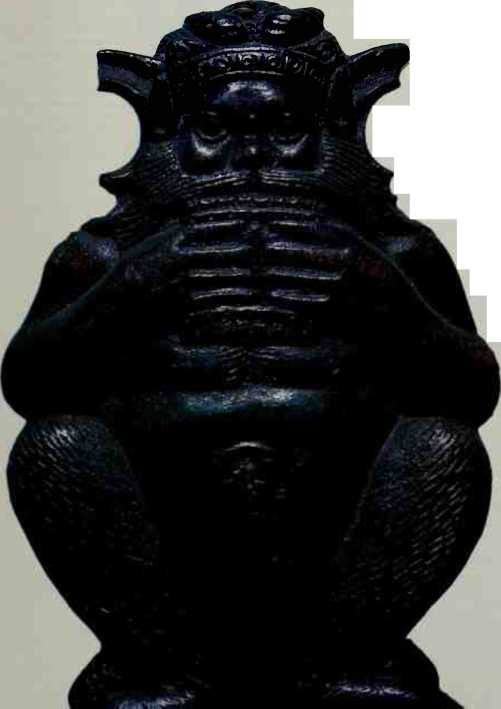
404 BC, citizens starved to death and Athens had no choice but to surrender its independence. But a pattern had been set, and the new overlords of the Mediterranean were to develop it even further.
Around 500 BC, when the Roman Republic was founded, the Italian peninsula was inhabited by a number of independent peoples, and much of the fertile land had already been tamed and put to use. Forests had been cleared around villages to provide either pasture for cattle, sheep, and goats or fields for growing grain and other crops. The Etruscan rulers of central Italy, the most powerful people in the region before the rise of Rome, had divided their estates into small plots for the use of the local population. These farmers also benefited from Etruscan land reclamation and drainage, which enabled the cultivation of areas that had previously been marshland or had been subject to flooding. The Romans had more far-reaching political ambitions than any of their neighbors, however, and in extending their territorial might, they set in motion a process that remodeled the landscape not just of Italy but of the entire Mediterranean region.
At its inception, the Roman Republic controlled an area of less than 400 square miles. By 260 BC, this domain had increased to almost 10,000 square miles, and Rome had forged alliances with other Latin states occupying an additional 40,000 square miles. At the end of the first century AD, the full-fledged Roman Empire extended from Spain in the west to Syria in the east, and from Britain in the north to the Sahara in the south. As with other empires both before and after, once the process of territorial expansion had begun, it acquired a momentum of its own. In the case of Rome, the impetus was the need to feed and clothe an ever-expanding population and to equip and pay ever-larger armies—which could be done only by gaining access to the natural resources of new provinces.
Within Italy itself, the increasing pressure on agricultural land led to changes both in the traditional system of landownership and in the uses to which the land was put. The citizens of the early republic were primarily subsistence farmers, small landholders providing for their families and trading their surplus produce for other goods. Conscripted to fight in an endless succession of foreign campaigns, many of these citizen-farmers were killed; others returned to find their farms overgrown. In due course, their land was taken over by the government, which then leased it to private individuals. Most of the best land was snatched up by enterprising aristocrats, who amalgamated select small farms into large estates. Slaves who were transported to Italy from the colonies abroad provided cheap labor, and the absentee landlords soon discovered that cash crops were a better investment than subsistence farming. As a result, the production of oil and wine for export began to take precedence over the growing of grain for local con-
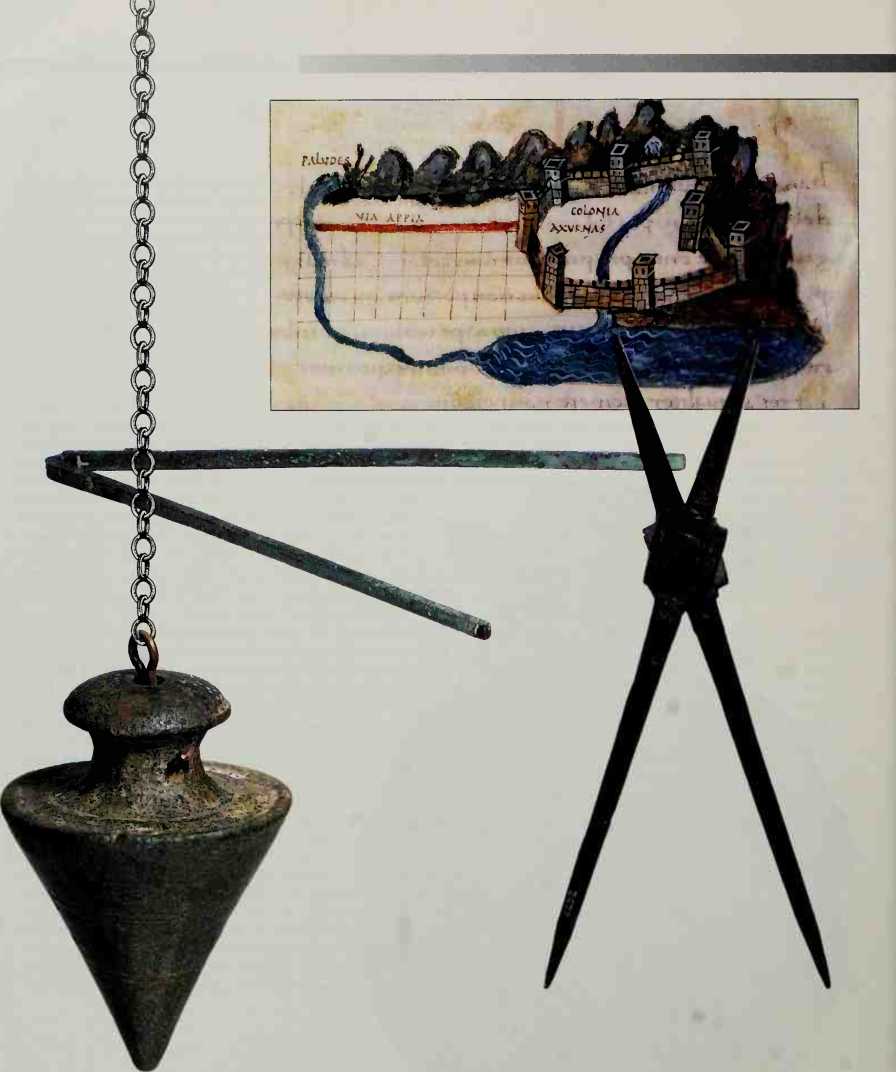
Sumption, and much of the land svas devoted to large-scale cattle and sheep ranching for meat, cheese, leather, and wool.
An agricultural treatise written in the second century BC by Cato the Elder, who himself owned several estates, gave detailed instructions on how to establish a large mixed farm for growing grapes, olives, timber, fruit, and cereal. The treatise included advice on the treatment of sick animals and on howto maintain the fertility of the soil by using the manure of domesticated animals as a fertilizer. In such practices, human ingenuity was being deliberately applied to the natural world with the aim of achieving maximum yields and profits. The new attitude was clearly expressed in a play by the Roman consul and writer Cicero, whose character Balbus the Stoic declares; "We enjoy the fruits of the plains and the mountains, the rivers and the lakes are ours, we sow wheat, we plant trees, we fertilize the soil by irrigation, we confine the rivers and straighten or divert their courses. In short, by means of our hands we essay to create a second world within the world of nature."
A map probably prepared in the eighth century AD to illustrate a text by a Roman surveyor shows a colony founded by the Romans in 329 BC in west central Italy after the conquest of a local people. A grid of lines intersecting at right angles divides the cultivable land into squares known as cenfor/ae—in theory, each square comprised 100 heritable plots. The territory was marked off by the use of a surveyor's cross, whose vertical alignment was established by plumb lines such as that on the far left, dating from the first century AD. Maps were then prepared for administrative purposes, using cartographic tools such as the folding rule and the pair of proportional compasses shown here, also from the first century AD. The gap between the lower points of the compasses is twice that between the upper points, enabling the drawing of a map at either half or double the scale of an existing one.
In the imposition of this "second world," the Romans made dramatic use of their engineering skills. Spectacular aqueducts were constructed to irrigate fields and to bring supplies of fresh water into cities. BeUveen the fourth century BC and the early second century AD, nine aqueducts measuring a total distance of 265 miles were constructed around the city of Rome; the aqueduct at NTmes in western Provence was 30 miles long and was lined and roofed with stone slabs. To speed the transport of fresh produce and to keep the empire's outposts in touch with the center of government in Rome, an elaborate netw'ork of roads was built across the landscape. Constructed in level terrain, these paved roads took the most direct routes to their destination—often striking straight through marshes or woodland—and were carried across rivers or deep ravines by soaring bridges and viaducts.
Engineering skills were also employed in mining gold, silver, copper, lead, and other metals. In open mines, torrents of water delivered by aqueducts—as much as nine million gallons a day at one site in northern Spain—were directed to loosen and break down deposits, and a series of sluice gates was used to process the waterborne debris. Trenches more than thirty feet deep were also cut for surface mining. To gain access to underground sources of metal, Roman engineers cut deep shafts and lined them with wood or stone; these led to a netw'ork of galleries that followed the direction of the vein to be mined. "Not only do they go into the ground a great distance," wrote the chronicler Diodorus Siculus in the first century BC, "but they also push their diggings many stades in depth and run galleries off at every angle, turning this way and that, in this manner bringing up from the depths the ore that gives them the profit they are seeking."
Underground lighting was provided by oil lamps placed in niches or on ledges. Water that flooded the galleries was removed either by the manual labor of thousands of slaves or, in some of the richer mines, by the water wheels or massive Archimedean screws that drew up water as they rotated—"an exceptionally ingenious machine," declared Diodorus, "by which an enormous amount of water is thrown out, to one's astonishment, by means of a trifling amount of labor."
Order and discipline were brought to bear on the surface of the land with similar rigor. In northern Italy and certain other parts of the empire, most publicly owned land was marked off by roads or paths intersecting at right angles into rectangles 2,400 Roman feet (2,300 feet) long; these plots were then divided into individual farms measuring between 25 and 100 acres. Villas—essentially farmsteads of above-
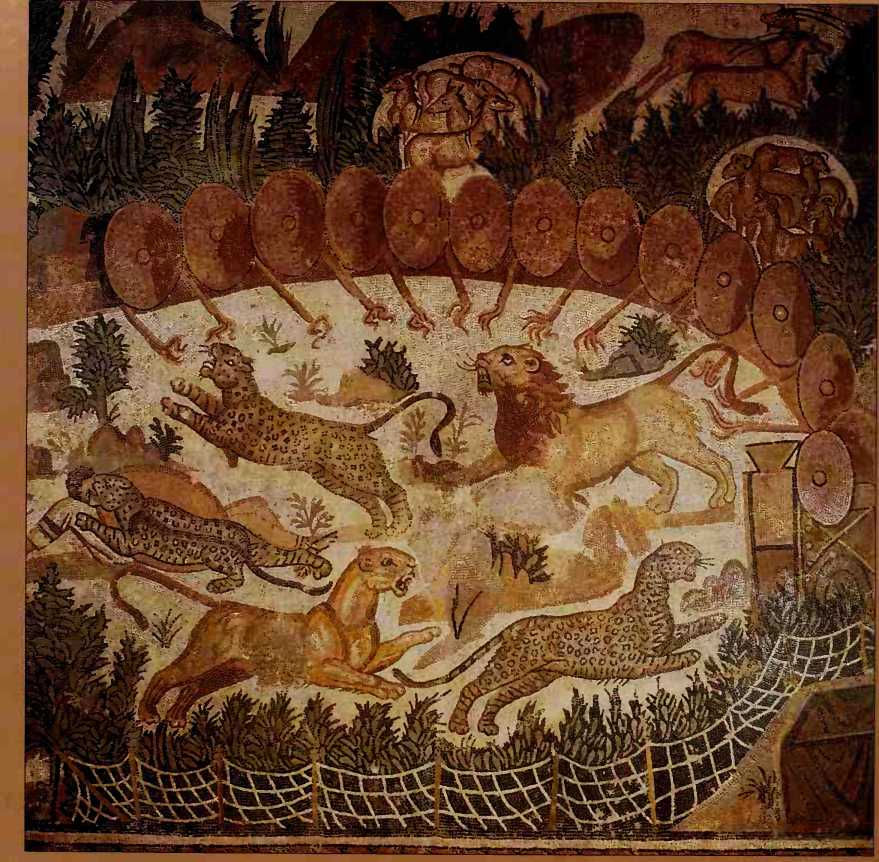
*u
Average size and sophistication, often containing facilities for oil and wine production, weaving, dyeing, and metalworking—replaced more basic agricultural settlements around major towns in the provinces. And after the North African city of Carthage was captured about 200 BC, the wide belt of fertile soil between the Mediterranean coast and the Sahara was rapidly exploited to produce grain for export to Rome. Much of the land was divided into a grid system of 125-acre squares, which were settled and farmed by military veterans. Woodland was cleared, and pastures and orchards were plowed under. "Cultivated fields have become the forests," observed the Carthaginian theologian Tertullian. "The sands are being planted, the rocks hewn, the swamp drained."
The timber from the forests that yielded to the plow was itself a highly prized commodity. Wood was virtually the only fuel available for heating, cooking, and the smelting of metal ore; it was used extensively for constructing houses and making furniture; and, above all, it sustained military conquest. The Roman natural historian Pliny the Elder recorded that during the first war against Carthage, a fleet of 120 wooden ships was built in sixty days, and for another naval campaign, 220 ships were built in just forty-five days. They were destroyed almost as quickly; According to another Roman historian, 700 quinqueremes—massive galleys with five banks of oars—were lost in that first war against Carthage. Armies were even more voracious in their appetite for timber: In addition to being used for fuel, wood was employed for building bridges, roads, defense works, and siege towers. One tower that was erected to storm the walls of Rhodes was described in detail by a chronicler: Nine stories high, its top platform was 150 feet above the ground, and it required a force of more than 1,000 men to move it into position.
This third-century mosaic from a Roman villa in present-day Algeria shows frantic leopards and lions being driven toward a net that is securely attached to stakes. While advancing on the animals, hunters push flaming torches from beneath their shields; on the left, one reckless pursuer has been caught and felled by a leopard. The purpose of such hunts was to capture the animals live for transportation to Rome, in whose thronged arenas they would be pitted against gladiators in bloody, spectacular contests. The local extinction of the elephant, the rhinoceros, and the zebra in North Africa and the hippopotamus from the lower Nile region in Egypt was largely a result of the Roman craze for imported exotic beasts.
Meanwhile, as the empire expanded, so too did the city of Rome: By the first century AD, the population of the capital had grown to more than one million. In 123 BC, the civic authorities had taken on the responsibility of distributing a free ration of wheat every month to all eligible citizens; slaves and those who did not qualify for the handouts were supplied by private merchants. The poorer inhabitants of Rome had, therefore, come to expect guaranteed supplies of food, and satisfying this demand became a political problem of increasing urgency. Around AD 50, the emperor Claudius was attacked in the Forum by a hungry mob who pelted him with pieces of stale bread. Recognizing that this was a situation as volatile as any on the empire's remote frontiers, Rome's rulers determined to buy off discontent with cheap bread and cheap thrills. Both elements in this policy of bread and circuses intensified what had now become a coordinated assault on the natural resources of the provinces. To keep the bellies of Rome's citizens full, wheat had to be supplied quickly and in bulk. And to take their minds off rebellion, animals—the wilder and the more exotic the better—had to be captured for bloody gladiatorial spectacles.
Most of Rome's wheat was supplied from Sicily, southwestern Spain, and North Africa. Their distance from Rome was not a great impediment: Despite the hazards of storms and piracy, it was cheaper and quicker to transport grain by sea than by overland route. But the drain on the agricultural resources of the provinces proved so great that many of their own inhabitants were left without sufficient food. Rome was consuming more than 6,500 tons of wheat per week at the beginning of the first century AD. To keep pace with this demand, at least 800 shiploads of wheat had to reach the port of Ostia on the Tiber River during the sailing season, which generally lasted from May to September. During the following century, the Greek physician
Galen complained that the "city dwellers, as it was their custom to collect and store enough grain for all the next year immediately after the harvest, carried off all the wheat, barley, beans, and lentils and left what remained to the countrypeople." The latter finished off their beans during the winter "and so had to fall back on unhealthy foods during the spring; they ate twigs and shoots of trees and bushes and bulbs and roots of indigestible plants; they filled themselves with wild herbs and cooked fresh grass."
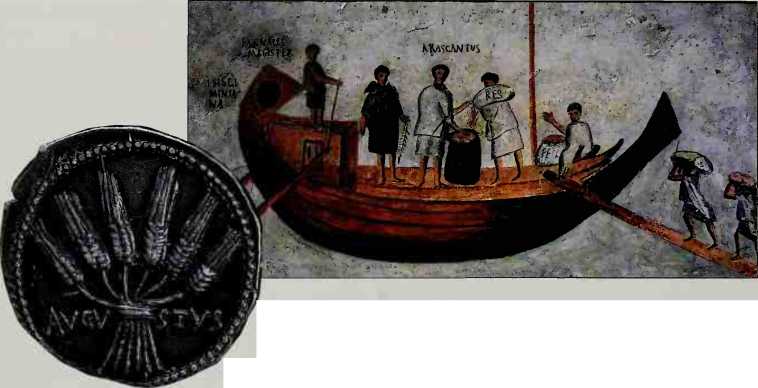
Standing at the helm of his ix)at, a captain supervises the loading of a cargo of grain in this third-century mosaic from Ostia at the mouth of the Tiber River. In the first century AD, about 330,000 tons of grain were carried each year to Ostia by seagoing freighters, chiefly from North Africa and Egypt; from the port's warehouses, a shuttle service of lighters sailed twenty miles upstream to Rome. The coin adorned with six stalks of wheat (inset), dating from 20 BC, commemorates the reorganization by Emperor Augustus of free supplies of grain for Roman citizens. His successor Tiberius warned the Senate that if this dole were discontinued, the "utter ruin of the state will follow."
Animals were also imported from abroad, and in such numbers that the larger species became extinct in regions accessible to professional hunters. The wealthy maintained a ruling-class tradition of keeping certain animals as pets: The emperor Hadrian erected tombstones over the graves of his favorite dogs, and many aristocrats kept monkeys, birds, and even fish as domestic playthings. But as far as ordinary Romans were concerned, animals were for providing meat and milk, hauling wagons, dragging plows—and for entertainment. Before massed crowds in the Circus Maximus and other stadiums, bears, elephants, lions, leopards, crocodiles, and rhinoceroses were slaughtered by professional fighters or goaded into destroying one another, having first been drugged with intoxicants to heighten their frenzy. Beasts that survived were shot with arrows by spectators who had paid extra for their ringside seats. The emperor Nero had 400 bears and 300 lions killed with javelins by his personal bodyguard. To celebrate his military victories. Emperor Trajan had 11,000 animals publicly butchered. Sensible citizens were appalled: "Can't you people see even this much, that bad examples recoil on those who set them?" asked the philosopher Seneca. But the policy served its immediate purpose, and the populace of Rome, sated, went peacefully to bed.
Warfare and agriculture, the twin engines of the empire, fed ceaselessly upon each other. Since the large estates in Italy, Sicily, and eventually, in North Africa were also worked by foreign slaves—the great markets of Capua and Delos were capable of handling 20,000 slaves per day—the dispossessed small landholders could not even sell their labor. They therefore drifted to the urban centers, increasing the demands that each city placed on its hinterland to provide for its citizens. Moreover, the ready availability of slaves discouraged the development of new agricultural techniques— so that output could be increased only by further military conquest, leading to an extension of the area under cultivation.
But this apparently endless cycle in fact contained its own constraints. First, there were the limits of human skill: The Romans proved unable to adapt their high-yield agricultural methods to the wetter climate and heavier soils of central and western Europe. Second, there were the limits of the land itself. Cleared, mined, and constantly plowed, the soil began to lose its fertility. Around AD 250, the Christian bishop of Carthage sent a warning to the Roman proconsul in Africa:
You must know that the world has grown old and does not remain in its former vigor. The rainfall and the sun's warmth are both diminishing; the metals are nearly exhausted; the husbandman is failing in his field. . . springs that once gushed forth liberally, now barely give a trickle of water.
For those with keen eyes, the evidence of this decline had been there to see at least 300 years earlier. The deforestation of the Italian Apennines during the wars against Carthage had allowed soil to be washed down the hillsides, silting up rivers and turning coastal areas into marshland—including the Pontine Marshes at the mouth of the Tiber River. Around 60 BC, the poet Lucretius observed that farmers were having to work harder than their ancestors to harvest the same amount of produce. But it was in North Africa and Asia Minor, the regions of the Mediterranean with the lowest
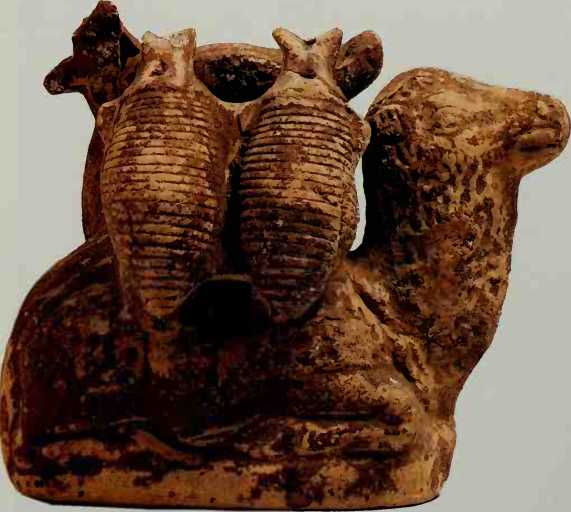
This third-century-BC Greek terra-cotta model of a camel bearing amphorae of wine was found in Syria, which exported grain to the populous city-states of Greece and received in return Greek wine, oil, and pottery. The fastest and cheapest method of transporting produce was by ship, but along caravan routes traversing the hot, dry regions of Asia and the Middle East, the camel came into its own. The animal's ability to store fat in its hump and to conserve body water, as well as its high tolerance of dehydration, enable it to travel for many days on a sparse diet of thorny bushes or dried grass. These attributes made the camel an ideal pack animal for the desert plains of North Africa, where it was introduced about the third century AD.
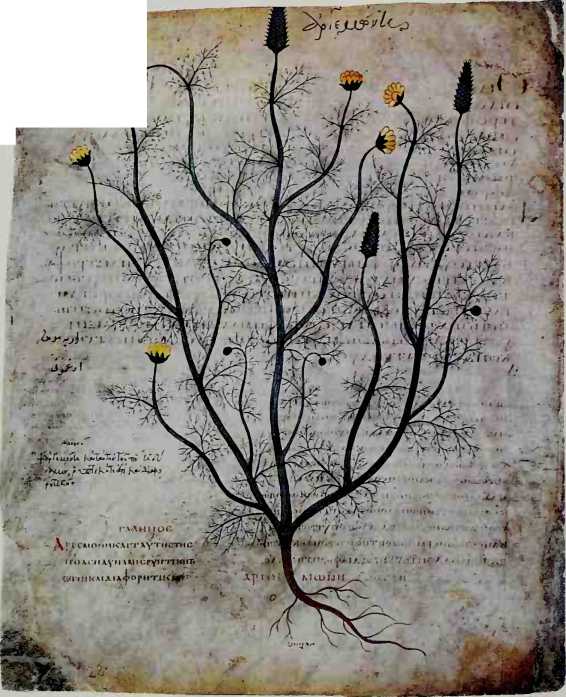
Rainfall, that the effects of overexploitation of the land were most conspicuous. Here, lush forests had once absorbed the precious winter rains and retained moisture in the soil around their roots. Now, with the trees gone, the soil exhausted, and supplies of manure too little or too distant to be brought in to replenish the land's fertility, the wind whipped away the dry topsoil, and the region began to turn to desert.
The Romans did take positive steps to conserve their resources. Marshland was drained in Italy, and terraces were carved in the hillsides of North Africa to hold rainfall or melting snow, which seeped slowly through the soil to fill the water table and replenish wells. In Rome in the first century AD, there was a lively market for recycled glass; Citizens collected fragments from the streets and sold them to local workshops, where less fuel was required to recycle the old product than was needed to make new glass from raw materials. At Ephesus, the major city of Asia Minor, where alluvium washed down from the hills by the Cayster River constantly threatened to silt up the port, the Romans repeatedly dredged the harbor and even attempted to divert the course of the river. But all such measures provided only a temporary alleviation of the problems.
Moreover, there were signs that the organizing genius and energy of Rome had begun to wane. "No addition whatever is being made to knowledge by means of original research," complained Pliny the Elder, "and, in fact, even the discoveries of our predecessors are not being thoroughly studied." Many ordinary citizens, especially among the military and lower classes, were dismayed by the manner in which the official Roman religion had become deeply intertwined with political protocol—some emperors even decreed that they themselves were gods—and switched their loyalties to charismatic mystery religions that flooded into Rome from the East. Among these were the cult of Isis, a version of sacrificial-bull rites that had flourished in Egypt centuries before, and a cult derived from the ancient Indo-European deity
A page from an eleventh-century Arabic edition of a Greek catalog of some 600 plants and their medicinal uses shows the agrimony plant, which was used to cure liver ailments. The inventory was compiled in the first century AD by Pedanius Dioscorides, one of a number of Greek scholars who rejected magical and divine explanations of diseases in favor of empirical observation of symptoms and cures. Subsequently translated into at least seven other languages, Dioscorides's work served as the primary text of pharmacology in Europe until the end of the fifteenth century.
Mithra, which also involved the sacrifice of bulls. A third contender for the allegiance of Romans who turned away from their traditional gods was Christianity, which despite fierce persecution made great strides among the populace. In the fourth century, Christianity was adopted as the official religion of the empire—a dangerous moment, for the new faith attacked the class system and rigid social hierarchy, built to a large extent on slave labor, on which the fortunes of Rome were based.
There were dangers from without, too. For centuries, the Romans had been menaced by nomadic raiders who lived on the open plains across the Danube River and preyed on the northern frontier. Batbari, the Greeks had called them, lampooning their incomprehensible, barking language. In the fourth century, these peoples began to advance south and west, swarming over the imperial defenses and into France, Spain, Italy, and North Africa.
Rome in its senescence, ruled by a succession of weak emperors and succumbing to a mood of fatalistic pessimism, could offer scant resistance to the invaders. In AD 476, Rome's control over the western empire, for some time hardly more than nominal, was officially terminated.
The inhabitants of the entire Mediterranean region and western Europe gradually came to realize that an era had ended. Merchant fleets, packed tight with grain, no longer converged on the wharves of Ostia. Mine shafts caved in. Water ran dry in aqueducts, and weeds sprouted in the precincts of abandoned temples and on roads once trodden by the marching feet of legions. To many witnesses it must have appeared as if the land itself, along with the power of Rome to which it had been harnessed, had grown old and impotent.
Even more gradually, however, the land began to reassert its own rhythms of growth, as if to prove that all along it had retained its essential independence—and though borrowed by Rome and put to Roman uses, it was itself no more Roman than it had been Minoan, Mycenaean, Greek, or Phoenician. Some regions, however, would never return to their former fruitfulness: The more eroded parts of North Africa became home not to settled farmers but to nomadic pastoralists, whose herds of goats and other foraging animals prevented new tree cover from growing. But most parts of the Mediterranean area, no longer subject to the overweening demands of Rome and its provincial capitals, now had to supply more immediate wants, and proved equal to that challenge. Rivers still flowed in a seasonal cycle of spate and decline; olives, vines, wheat, barley, and a variety of vegetables nourished the people of villages and small towns.
Lapsed from the severe and uniform regimen of the Romans, the resilient Mediterranean landscape became a mosaic of varied and productive local agricultures— and would remain so until the technology and mass demands of the twentieth century imposed their own exacting monocultures. Even these did not trespass—for by then there was profit in tourism, as well as a judicious sense of limits—on the hollow stone ruins of Greece and Rome.
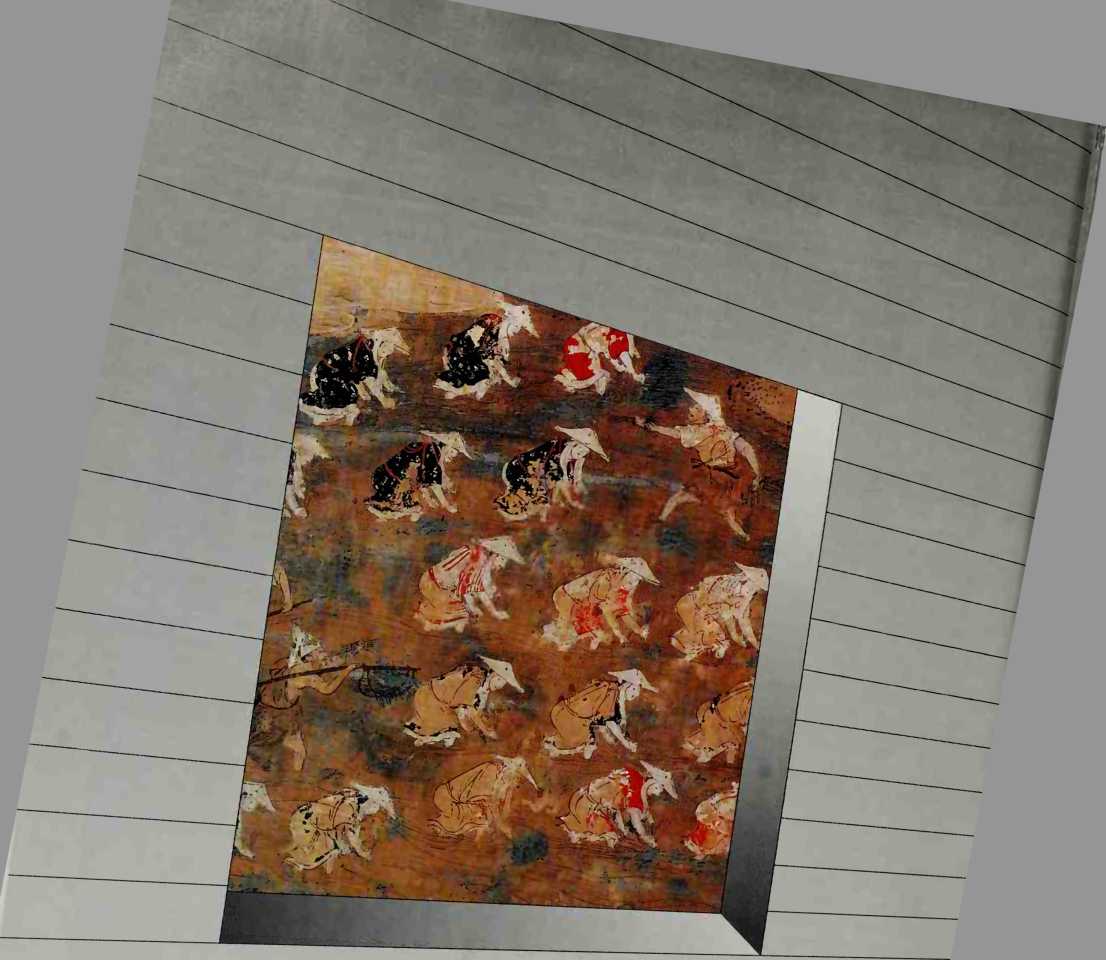
A detail from a sixteenth-century Japanese screen shows a team of women planting rice in a flooded field, where the seedlings will remain until the field is drained in preparation for harvesting. Wet cultivation of rice was established in China possibly by the end of the fifth millennium BC; around SOO BC, it spread to Japan and also to India and many parts of Southeast Asia. Rice growing, though one of the most highly labor-intensive forms of agriculture, is also one of the most productive: Rice today is the chief food for three out of five of the world's inhabitants. In many Eastern countries, bandfuls of rice are thrown over newly married couples to wish them fertility, a custom from which the Western practice of scattering confetti derives.




 World History
World History









